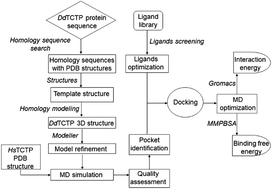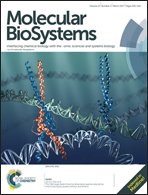Identification of novel inhibitors of the translationally controlled tumor protein (TCTP): insights from molecular dynamics†‡
Abstract
The translationally controlled tumor protein (TCTP) is a highly conserved multifunctional protein, preferentially expressed in mitotically active tissues and is a potential biomarker and a therapeutic target for lung cancers. An understanding of the biology of this molecule and model systems for the screening of drugs is still awaited. In the absence of complete crystal structure, NMR structures as templates were used for homology modeling and MD optimization of both Dictyostelium discoideum and human TCTPs, which was followed by pocket-site prediction, ligand screening and docking. Rescoring of TCTP–ligand complexes was done using MD and MM-PBSA approaches. D. discoideum TCTP was expressed under a constitutive promoter and the endogenous RNA in multicellular structures formed was localized by in situ hybridization. Based on the interactions and binding energy scores, two novel compounds were identified as the best potential inhibitors that could be further used for the development of drug candidates. Inhibition of cell proliferation was observed in the strain overexpressing Dictyostelium TCTP and in situ hybridization results show them to be localized in the prestalk (dying cell population) cells. D. discoideum and human TCTPs share similar dynamic behaviors; overexpression of Dictyostelium TCTP inhibits cell proliferation. D. discoideum could be used as a model system for understanding the biology of this molecule and also for drug screening.



 Please wait while we load your content...
Please wait while we load your content...